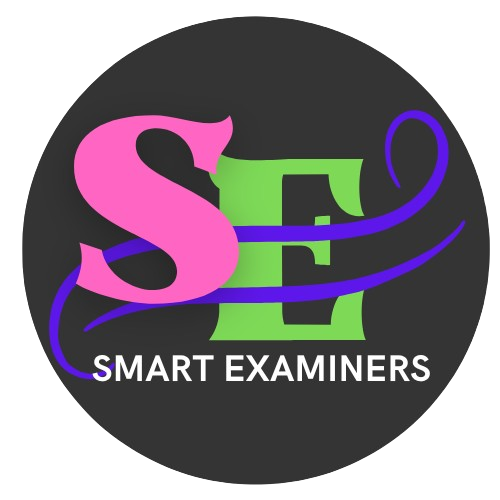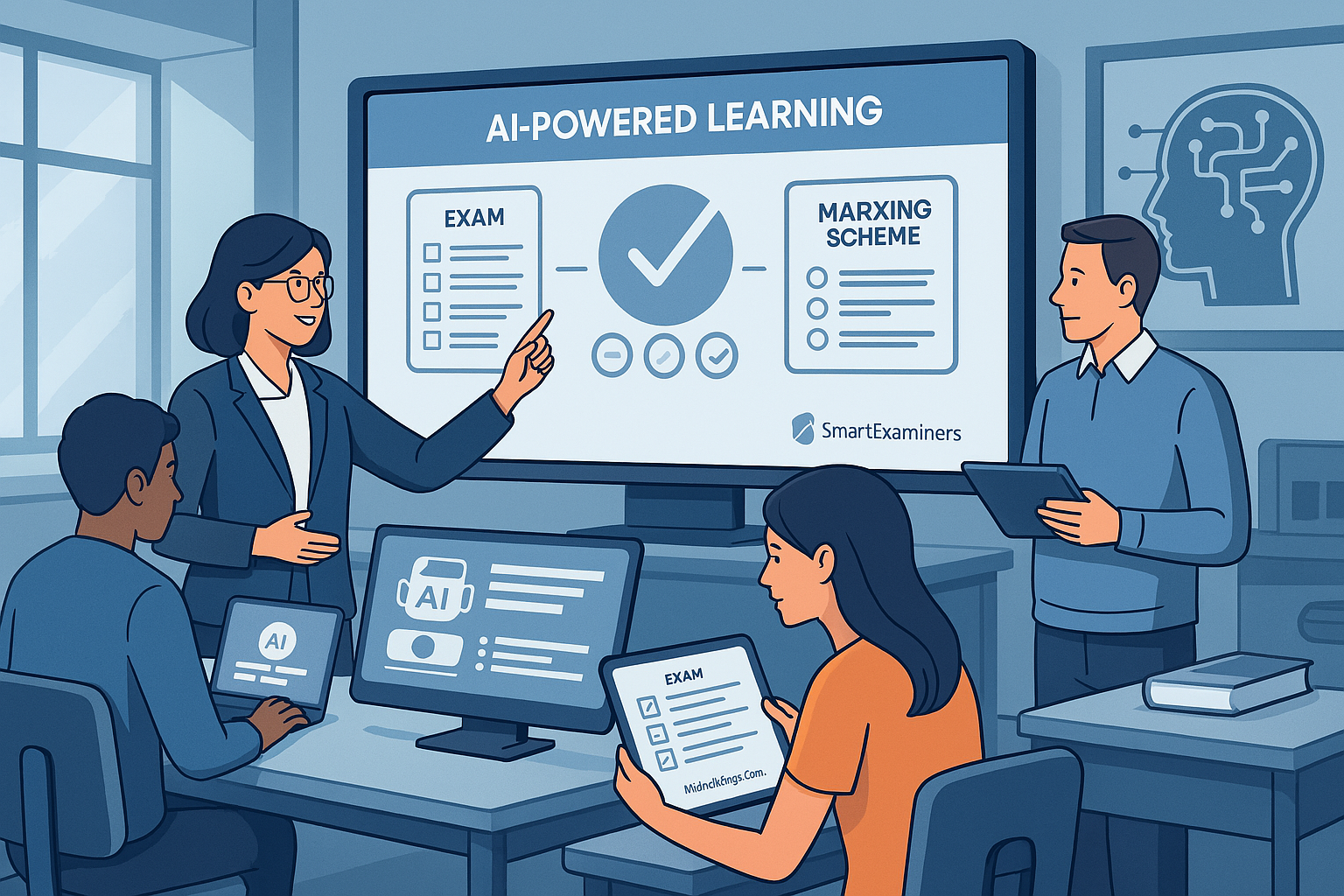📚 What is SAMR in Education? A Comprehensive Guide for 2025
🧠 Introduction
In today's rapidly evolving educational landscape, integrating technology effectively is paramount. The SAMR model, developed by Dr. Ruben Puentedura, offers a structured framework for educators to assess and enhance their use of technology in teaching and learning. This guide delves deep into the SAMR model, its stages, applications, and how tools like SmartExaminers can revolutionize curriculum-aligned assessments.
🔍 Understanding the SAMR Model
The SAMR model categorizes technology integration into four progressive levels:
- Substitution: Technology acts as a direct substitute, with no functional change.
- Augmentation: Technology acts as a direct substitute, with functional improvements.
- Modification: Technology allows for significant task redesign.
- Redefinition: Technology allows for the creation of new tasks previously inconceivable.
This hierarchy encourages educators to move beyond mere replacement of traditional methods, aiming for transformative learning experiences.
🧩 Detailed Exploration of SAMR Levels
1. 📝 Substitution
At this level, technology replaces traditional tools without altering the task.
Examples:
- Using a word processor instead of pen and paper.
- Reading e-books instead of physical textbooks.
- Viewing recorded lectures instead of attending in person.
AI Integration:
- Employing AI-powered text-to-speech tools to read content aloud.
- Using AI to generate basic worksheets, saving time on manual creation.
2. 🛠️ Augmentation
Here, technology enhances the task, offering functional improvements.
Examples:
- Incorporating interactive quizzes with instant feedback.
- Utilizing grammar-checking tools to improve writing.
- Engaging with multimedia presentations to enrich content delivery.
AI Integration:
- AI-driven platforms providing personalized reading recommendations based on student interests and reading levels.
- AI tools offering detailed feedback on writing, beyond basic grammar checks.
3. 🔧 Modification
Technology allows for significant redesign of tasks, enhancing learning experiences.
Examples:
- Students collaborating on shared documents in real-time.
- Creating podcasts or videos instead of traditional essays.
- Implementing flipped classrooms where students engage with content at home and practice in class.
AI Integration:
- AI tools assisting students in creating interactive simulations or models.
- Platforms like SmartExaminers generating customized assessments aligned with curriculum standards.
4. 🚀 Redefinition
At this pinnacle level, technology enables tasks that were previously inconceivable.
Examples:
- Virtual reality field trips to historical sites.
- Global collaboration projects connecting students worldwide.
- Developing apps or games to demonstrate understanding of concepts.
AI Integration:
- AI facilitating real-time language translation during global collaborations.
- Advanced AI simulations allowing students to experiment with complex scenarios safely.
🧠 The Significance of the SAMR Model
The SAMR model serves as a roadmap for educators aiming to integrate technology meaningfully. By progressing through its levels, teachers can:
- Enhance student engagement and motivation.
- Foster critical thinking and creativity.
- Prepare students for a technology-driven world.
- Continuously reflect and improve upon teaching practices.
🤖 Integrating AI with SAMR: The Role of SmartExaminers
Artificial Intelligence (AI) is reshaping education, offering tools that align seamlessly with the SAMR model. SmartExaminers, for instance, is an AI-powered platform that aids in creating curriculum-aligned assessments and marking schemes.
Benefits of SmartExaminers:
- Efficiency: Automates the creation of assessments, saving educators valuable time.
- Customization: Generates exams tailored to specific curriculum standards and student needs.
- Feedback: Provides instant, detailed feedback, enhancing student learning.
- Data-Driven Insights: Analyzes student performance to inform instructional strategies.
By leveraging such AI tools, educators can move beyond substitution, embracing modification and redefinition in their teaching practices.
🌍 Global Perspectives: SAMR in Diverse Educational Contexts
The application of the SAMR model varies across different educational settings:
- Developed Regions: Often have access to advanced technologies, facilitating higher levels of SAMR integration.
- Developing Regions: May face challenges like limited infrastructure, but innovative solutions (e.g., mobile learning) can still enable meaningful technology integration.
Regardless of context, the SAMR model provides a flexible framework adaptable to various resources and needs.
📈 Implementing SAMR: Strategies for Educators
To effectively integrate the SAMR model:
- Assess Current Practices: Identify where current technology use falls within the SAMR framework.
- Set Goals: Aim to progress to higher levels of integration over time.
- Professional Development: Engage in training to enhance technological proficiency.
- Collaborate: Share experiences and strategies with peers.
- Reflect and Adjust: Continuously evaluate the impact of technology on student learning and make necessary adjustments.
🛠️ Overcoming Challenges in SAMR Implementation
While the SAMR model offers a clear pathway, educators may encounter challenges during implementation. Here are some common obstacles and strategies for overcoming them:
1. 💻 Access to Technology
- Challenge: In some regions or schools, access to technology might be limited due to budget constraints or infrastructural issues.
- Solution: Start small by leveraging affordable or free tools such as smartphones, open-source software, and mobile learning apps. You can also utilize blended learning models where technology complements traditional teaching methods.
2. ⏳ Time Constraints
- Challenge: Teachers may find it difficult to integrate technology into already packed curricula, leading to time management issues.
- Solution: Plan technology integration strategically, focusing on tasks that provide the greatest learning value. Start with simpler applications that can be scaled over time. Using platforms like SmartExaminers to automate assessments can save valuable time for teachers.
3. 🧑🏫 Resistance to Change
- Challenge: Some educators might be resistant to adopting new technology due to lack of confidence or unfamiliarity with digital tools.
- Solution: Provide ongoing professional development and create a supportive environment where teachers can experiment with new tools. Peer collaboration can also help ease the transition. Highlight the benefits of technology integration, such as increased student engagement and personalized learning experiences.
4. 🌐 Lack of Training
- Challenge: Teachers may not have the required skills to use advanced technology effectively.
- Solution: Schools should invest in training programs for teachers, focusing on both technical skills and pedagogical strategies for using technology in the classroom. Engaging with communities of practice and attending workshops can also be beneficial.
🧑🎓 SAMR and Personalized Learning
One of the most powerful aspects of the SAMR model is its potential to support personalized learning. By using technology in higher levels of the SAMR model (Modification and Redefinition), educators can tailor learning experiences to meet individual student needs.
For example:
- Substitution: Using educational apps to provide alternative ways of learning material (e.g., videos or interactive text).
- Augmentation: Personalized quizzes or adaptive learning tools that adjust the difficulty based on student performance.
- Modification: Allowing students to choose their learning path through project-based learning and digital portfolios.
- Redefinition: Facilitating global collaboration through online platforms, enabling students to work on real-world projects with peers from different countries.
This approach helps students learn at their own pace, fostering greater engagement and mastery of content.
📊 SAMR and Assessment with SmartExaminers
Another key area where SAMR shines is in assessment. Traditional assessments, while effective, can be time-consuming and may not fully capture a student's understanding. By integrating technology through the SAMR model, assessments can become more dynamic, interactive, and tailored to individual needs.
How SmartExaminers Aligns with SAMR:
- Substitution: SmartExaminers can automate basic quiz creation, replacing traditional paper-based tests.
- Augmentation: It offers instant feedback on student responses, enhancing the feedback process and enabling timely intervention.
- Modification: Teachers can create customized assessments that align with specific curriculum standards, ensuring that each exam is tailored to the class’s needs.
- Redefinition: AI-powered assessments that adapt to a student's level of understanding, providing a truly personalized exam experience.
The integration of AI with the SAMR model can transform assessment from a simple evaluative tool into a comprehensive learning resource, improving student performance and engagement.
🏆 SAMR in Practice: Success Stories
Several schools and educators have successfully implemented the SAMR model to enhance teaching and learning. Here are a few notable examples:
1. 🌟 The Flipped Classroom at High Tech High
At High Tech High in San Diego, teachers used the SAMR model to flip their classrooms. Instead of traditional lecture-based teaching, students engaged with learning materials (such as videos and interactive simulations) at home and used classroom time for hands-on projects and collaboration.
By utilizing the Redefinition level of the SAMR model, High Tech High created a learning environment where students were more actively involved in their education, leading to higher engagement and improved learning outcomes.
2. 🌍 Global Collaboration Projects in Australia
A school in Australia integrated the SAMR model to facilitate global collaboration projects. Through virtual platforms, students worked on joint projects with peers in other countries. This allowed students to not only engage with real-world problems but also develop critical 21st-century skills like communication, problem-solving, and collaboration.
By leveraging the Redefinition stage, the school provided students with experiences they would have never had in a traditional classroom, making learning more relevant and impactful.
💡 Future of SAMR in Education
As technology continues to evolve, the SAMR model is poised to become even more central in shaping future educational practices. With the rise of AI, virtual reality, and other advanced tools, the potential for redefining learning experiences is vast.
- AI-Powered Learning: With AI continuing to advance, we can expect to see more personalized and adaptive learning experiences. AI can assess student progress in real-time, providing teachers with detailed insights to adjust their teaching methods accordingly.
- Virtual and Augmented Reality: As VR and AR technologies become more accessible, they will likely play a huge role in redefinition and modification, creating immersive learning experiences that were once impossible.
- Collaborative Learning Platforms: The future of education will likely see more global collaboration, where students can connect with their peers worldwide. Platforms like SmartExaminers can help bridge the gap by creating assessments and providing AI-generated insights across borders.
📚 Conclusion: SAMR and the Future of Education
The SAMR model serves as a powerful tool for educators to understand and enhance their integration of technology in the classroom. By moving through the stages from Substitution to Redefinition, educators can transform their teaching practices and provide students with more meaningful, engaging learning experiences.
Whether through personalized assessments with SmartExaminers, interactive global collaborations, or innovative use of VR and AR, the SAMR model offers endless opportunities for growth. As technology continues to evolve, so too will the possibilities for transformative education.
Stay tuned for more updates and tips on how to enhance your teaching practices with technology!
 SmartExaminers
SmartExaminers


